MBA643: Project Risk, Finance and Monitoring: Case Study
VerifiedAdded on 2023/01/24
|17
|3511
|77
Project
AI Summary
This project report provides a comprehensive analysis of the North-East Link project in Melbourne, focusing on project risk, finance, and monitoring. The report begins with an overview of the project, including its budget (estimated at $5-$10 billion, potentially rising to $15 billion with risk management), social and economic rationale, key statistics (scope, size, time required, and key construction elements), funding mechanisms, and key stakeholders. The core of the report is a detailed risk analysis, which identifies and rates potential risks such as transport disruptions, air quality degradation, noise and vibration, land use issues, and impacts on businesses, arboriculture, landscape, social aspects, human health, historical and aboriginal cultural heritage, ground movement, groundwater contamination, surface water pollution, and ecological impacts. Each risk is assessed based on likelihood and consequence, and a risk matrix is provided to determine risk ratings. Finally, the report presents a risk mitigation plan, detailing strategies to minimize environmental, social, and financial impacts. The mitigation plan addresses air pollution, noise and vibration, land acquisition, and ecological balance, with considerations for budget adjustments due to the implementation of these measures. The project underscores the importance of proactive risk management in large-scale infrastructure projects.

Running Head: PROJECT RISK, FINANCE AND MONITORING
MBA643: Project Risk, Finance and Monitoring
Name of the Student
Name of the University
MBA643: Project Risk, Finance and Monitoring
Name of the Student
Name of the University
Paraphrase This Document
Need a fresh take? Get an instant paraphrase of this document with our AI Paraphraser
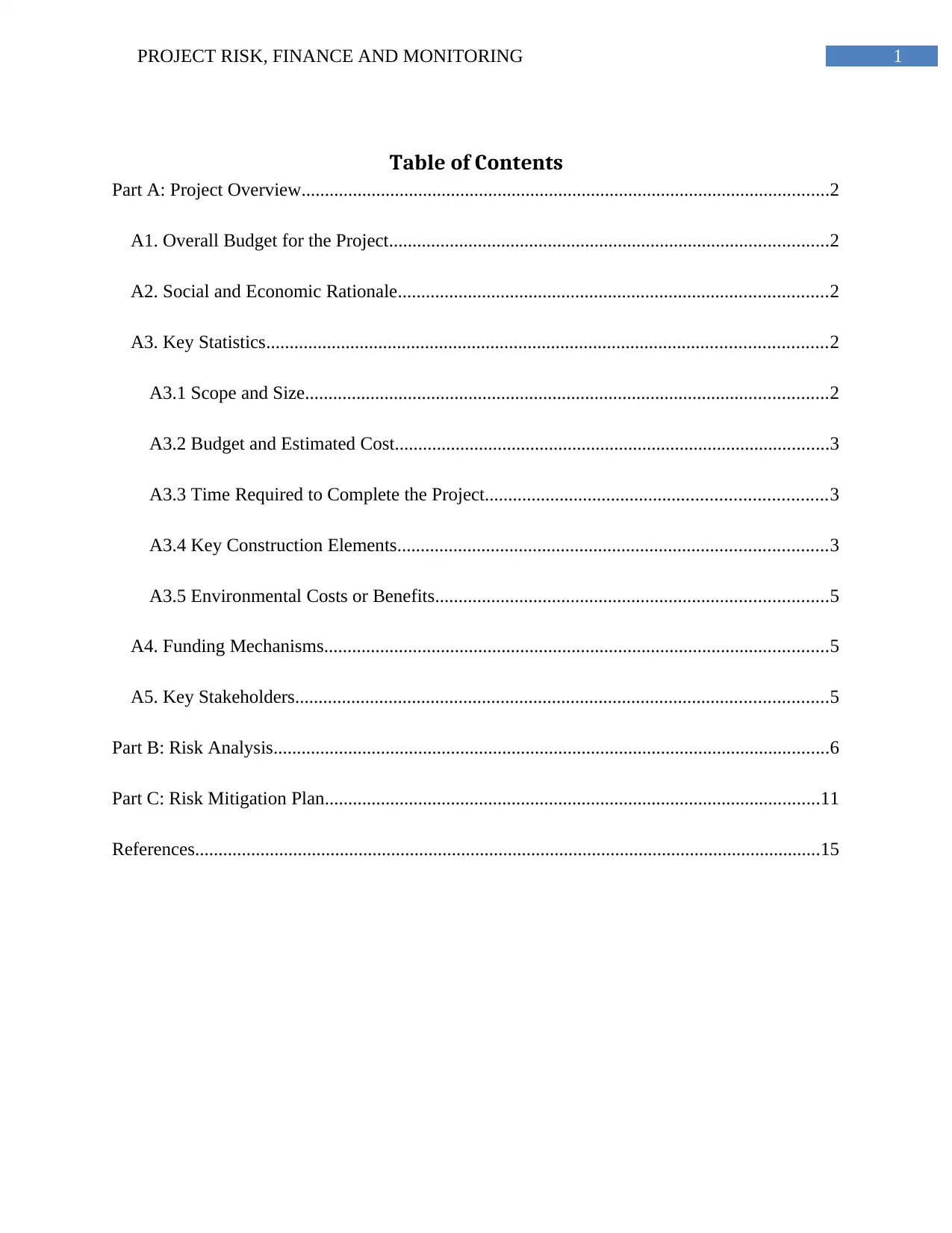
1PROJECT RISK, FINANCE AND MONITORING
Table of Contents
Part A: Project Overview.................................................................................................................2
A1. Overall Budget for the Project..............................................................................................2
A2. Social and Economic Rationale............................................................................................2
A3. Key Statistics........................................................................................................................2
A3.1 Scope and Size................................................................................................................2
A3.2 Budget and Estimated Cost.............................................................................................3
A3.3 Time Required to Complete the Project.........................................................................3
A3.4 Key Construction Elements............................................................................................3
A3.5 Environmental Costs or Benefits....................................................................................5
A4. Funding Mechanisms............................................................................................................5
A5. Key Stakeholders..................................................................................................................5
Part B: Risk Analysis.......................................................................................................................6
Part C: Risk Mitigation Plan..........................................................................................................11
References......................................................................................................................................15
Table of Contents
Part A: Project Overview.................................................................................................................2
A1. Overall Budget for the Project..............................................................................................2
A2. Social and Economic Rationale............................................................................................2
A3. Key Statistics........................................................................................................................2
A3.1 Scope and Size................................................................................................................2
A3.2 Budget and Estimated Cost.............................................................................................3
A3.3 Time Required to Complete the Project.........................................................................3
A3.4 Key Construction Elements............................................................................................3
A3.5 Environmental Costs or Benefits....................................................................................5
A4. Funding Mechanisms............................................................................................................5
A5. Key Stakeholders..................................................................................................................5
Part B: Risk Analysis.......................................................................................................................6
Part C: Risk Mitigation Plan..........................................................................................................11
References......................................................................................................................................15

2PROJECT RISK, FINANCE AND MONITORING
Part A: Project Overview
A1. Overall Budget for the Project
The overall budget for the project is not completely finalized but it has been estimated
that the project will cost between $5 and $10 billion.
A2. Social and Economic Rationale
This project is set to benefit the urban growth of the city of Melbourne. It has always
been considered that the North end and the East end are not sufficiently connected together with
a high speed network and as a result, there are extreme traffic blockages during the rush hours.
For years, the Australian daily passengers residing in Melbourne have been demanding a new
network that would connect the northern and eastern parts of the main city as well as its outskirts
(Li 2016). The new proposed high speed road network will definitely solve this issue and will
significantly reduce the traffic on the normal roads. Moreover, the current roads are extremely
old and often require high amount of maintenance costs due to frequent damages caused by over-
pressure of regular traffic. The new high speed network will not only reduce the pressure on
these roads but also generate a source of income through toll booths.
A3. Key Statistics
A3.1 Scope and Size
The scope of the project is to construct the North-East Link for the city of Melbourne.
The North-East Link will also consist of the following components.
i. Northern Section (M80 to Lower Plenty Road)
Part A: Project Overview
A1. Overall Budget for the Project
The overall budget for the project is not completely finalized but it has been estimated
that the project will cost between $5 and $10 billion.
A2. Social and Economic Rationale
This project is set to benefit the urban growth of the city of Melbourne. It has always
been considered that the North end and the East end are not sufficiently connected together with
a high speed network and as a result, there are extreme traffic blockages during the rush hours.
For years, the Australian daily passengers residing in Melbourne have been demanding a new
network that would connect the northern and eastern parts of the main city as well as its outskirts
(Li 2016). The new proposed high speed road network will definitely solve this issue and will
significantly reduce the traffic on the normal roads. Moreover, the current roads are extremely
old and often require high amount of maintenance costs due to frequent damages caused by over-
pressure of regular traffic. The new high speed network will not only reduce the pressure on
these roads but also generate a source of income through toll booths.
A3. Key Statistics
A3.1 Scope and Size
The scope of the project is to construct the North-East Link for the city of Melbourne.
The North-East Link will also consist of the following components.
i. Northern Section (M80 to Lower Plenty Road)
⊘ This is a preview!⊘
Do you want full access?
Subscribe today to unlock all pages.

Trusted by 1+ million students worldwide
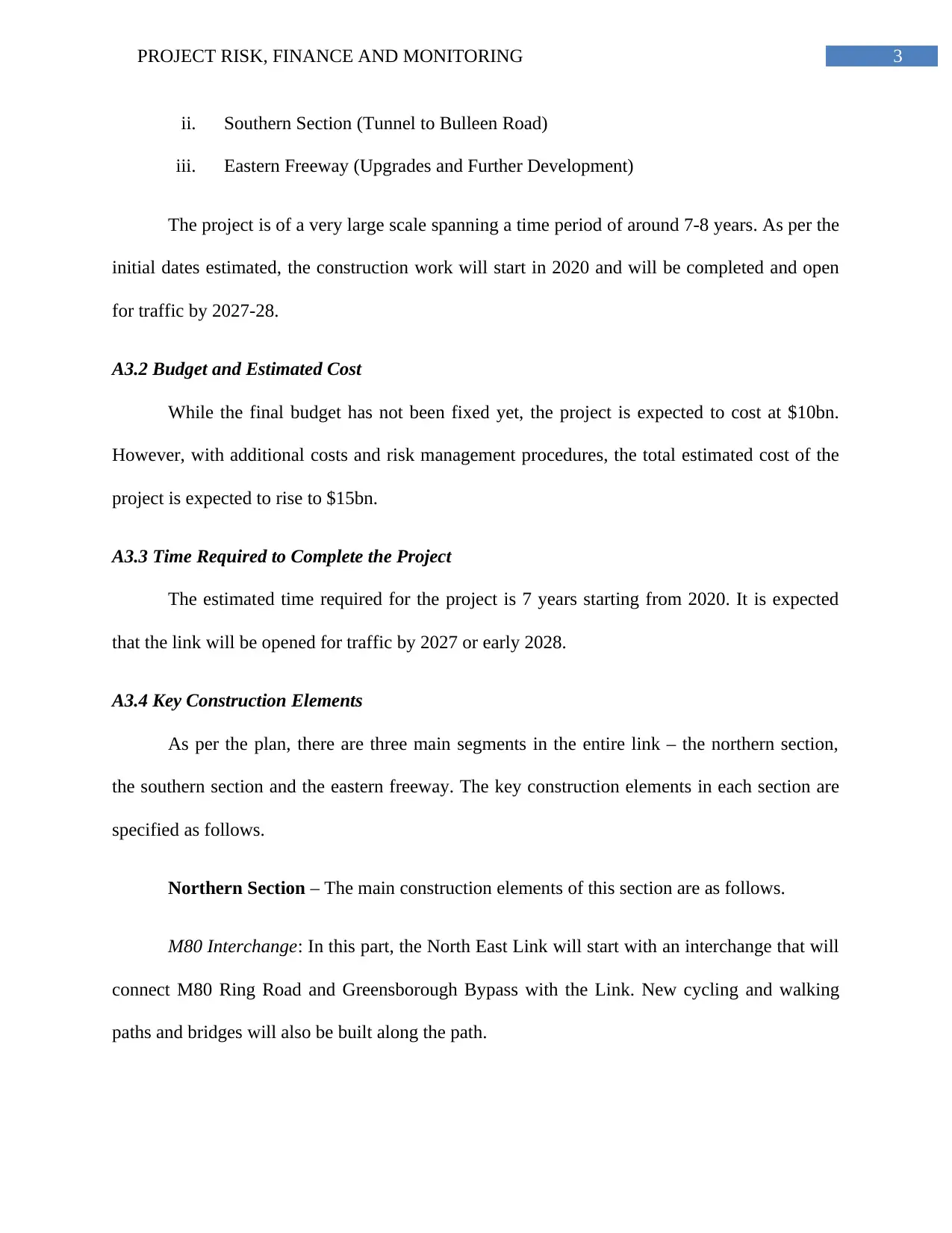
3PROJECT RISK, FINANCE AND MONITORING
ii. Southern Section (Tunnel to Bulleen Road)
iii. Eastern Freeway (Upgrades and Further Development)
The project is of a very large scale spanning a time period of around 7-8 years. As per the
initial dates estimated, the construction work will start in 2020 and will be completed and open
for traffic by 2027-28.
A3.2 Budget and Estimated Cost
While the final budget has not been fixed yet, the project is expected to cost at $10bn.
However, with additional costs and risk management procedures, the total estimated cost of the
project is expected to rise to $15bn.
A3.3 Time Required to Complete the Project
The estimated time required for the project is 7 years starting from 2020. It is expected
that the link will be opened for traffic by 2027 or early 2028.
A3.4 Key Construction Elements
As per the plan, there are three main segments in the entire link – the northern section,
the southern section and the eastern freeway. The key construction elements in each section are
specified as follows.
Northern Section – The main construction elements of this section are as follows.
M80 Interchange: In this part, the North East Link will start with an interchange that will
connect M80 Ring Road and Greensborough Bypass with the Link. New cycling and walking
paths and bridges will also be built along the path.
ii. Southern Section (Tunnel to Bulleen Road)
iii. Eastern Freeway (Upgrades and Further Development)
The project is of a very large scale spanning a time period of around 7-8 years. As per the
initial dates estimated, the construction work will start in 2020 and will be completed and open
for traffic by 2027-28.
A3.2 Budget and Estimated Cost
While the final budget has not been fixed yet, the project is expected to cost at $10bn.
However, with additional costs and risk management procedures, the total estimated cost of the
project is expected to rise to $15bn.
A3.3 Time Required to Complete the Project
The estimated time required for the project is 7 years starting from 2020. It is expected
that the link will be opened for traffic by 2027 or early 2028.
A3.4 Key Construction Elements
As per the plan, there are three main segments in the entire link – the northern section,
the southern section and the eastern freeway. The key construction elements in each section are
specified as follows.
Northern Section – The main construction elements of this section are as follows.
M80 Interchange: In this part, the North East Link will start with an interchange that will
connect M80 Ring Road and Greensborough Bypass with the Link. New cycling and walking
paths and bridges will also be built along the path.
Paraphrase This Document
Need a fresh take? Get an instant paraphrase of this document with our AI Paraphraser

4PROJECT RISK, FINANCE AND MONITORING
Grimshaw Street: The North East Link will be built under the Grimshaw Street for
through traffic and for the traffic wanting to enter Grimshaw Street from the Link, interchanges
will be constructed as well.
Watsonia Station and Shops: The North East Link will be developed in this part in such a
way that it is well linked with the Watsonia Station, shops and bus depots that can be easily
accessed by the passengers coming through the Link.
Greensborough Road: At this section, the Link will enter into a 12 m deep trench
adjacent to the Greensborough Road for through traffic. In addition, the Link will also be
connected to Greensborough Road through green path where walkways and various shops can
also be set up.
Lower Plenty Road Interchange and Tunnel Entrance: At this section, Victoria’s longest
twin road tunnels will start at Blamey Road. Walking and cycling path along the route will also
be constructed.
Southern Section – The main construction elements of this section are as follows.
Twin Tunnels: The tunnels that started in the Northern Section will come up to the
Southern Section. The main benefits of the tunnels are that the residential areas will not be
disturbed and there will be no bridges required on the Yarra River.
Manningham Road Interchange: In this section, an interchange will be constructed for
the drivers who wish to go off the North East Link and move into the Manningham Road.
Another interchange and tunnel portal will link the road to the Eastern Freeway as the North East
Link will continue further south.
Grimshaw Street: The North East Link will be built under the Grimshaw Street for
through traffic and for the traffic wanting to enter Grimshaw Street from the Link, interchanges
will be constructed as well.
Watsonia Station and Shops: The North East Link will be developed in this part in such a
way that it is well linked with the Watsonia Station, shops and bus depots that can be easily
accessed by the passengers coming through the Link.
Greensborough Road: At this section, the Link will enter into a 12 m deep trench
adjacent to the Greensborough Road for through traffic. In addition, the Link will also be
connected to Greensborough Road through green path where walkways and various shops can
also be set up.
Lower Plenty Road Interchange and Tunnel Entrance: At this section, Victoria’s longest
twin road tunnels will start at Blamey Road. Walking and cycling path along the route will also
be constructed.
Southern Section – The main construction elements of this section are as follows.
Twin Tunnels: The tunnels that started in the Northern Section will come up to the
Southern Section. The main benefits of the tunnels are that the residential areas will not be
disturbed and there will be no bridges required on the Yarra River.
Manningham Road Interchange: In this section, an interchange will be constructed for
the drivers who wish to go off the North East Link and move into the Manningham Road.
Another interchange and tunnel portal will link the road to the Eastern Freeway as the North East
Link will continue further south.

5PROJECT RISK, FINANCE AND MONITORING
Eastern Freeway – This section already exists and as a part of this project, this section
will be repaired and modified and some part will be reconstructed.
A3.5 Environmental Costs or Benefits
In addition to the construction, the project also focuses on conservation of the
environment throughout the course of the construction. Green corridors will be constructed
throughout the course of the Link in addition to minimization of materials wastage that would
cause negative impact on the environment (Lopez, Mascione & Liu 2017, p. 207-217). A major
portion of the road includes underground tunnels so that the environment above the surface is not
disturbed during construction or even when the link will be open for traffic. Low vibration
machineries will be used for the construction as well. Overall, these steps will increase the
budget of the project but will help gain environmental benefits in the near future.
A4. Funding Mechanisms
Since this is a long term project with a huge budget, Victoria government will fund for
the project in different phases. The government will make yearly payment for funding the project
depending on the progress available in the project.
A5. Key Stakeholders
The key stakeholders in this project are shown in the following table.
Victorian government Federal government Local government
Private road operators Market Landowners
Traditional owners and
indigenous groups
Transport peak bodies Road users
Freight industry Transport operators Community and environment
Eastern Freeway – This section already exists and as a part of this project, this section
will be repaired and modified and some part will be reconstructed.
A3.5 Environmental Costs or Benefits
In addition to the construction, the project also focuses on conservation of the
environment throughout the course of the construction. Green corridors will be constructed
throughout the course of the Link in addition to minimization of materials wastage that would
cause negative impact on the environment (Lopez, Mascione & Liu 2017, p. 207-217). A major
portion of the road includes underground tunnels so that the environment above the surface is not
disturbed during construction or even when the link will be open for traffic. Low vibration
machineries will be used for the construction as well. Overall, these steps will increase the
budget of the project but will help gain environmental benefits in the near future.
A4. Funding Mechanisms
Since this is a long term project with a huge budget, Victoria government will fund for
the project in different phases. The government will make yearly payment for funding the project
depending on the progress available in the project.
A5. Key Stakeholders
The key stakeholders in this project are shown in the following table.
Victorian government Federal government Local government
Private road operators Market Landowners
Traditional owners and
indigenous groups
Transport peak bodies Road users
Freight industry Transport operators Community and environment
⊘ This is a preview!⊘
Do you want full access?
Subscribe today to unlock all pages.

Trusted by 1+ million students worldwide
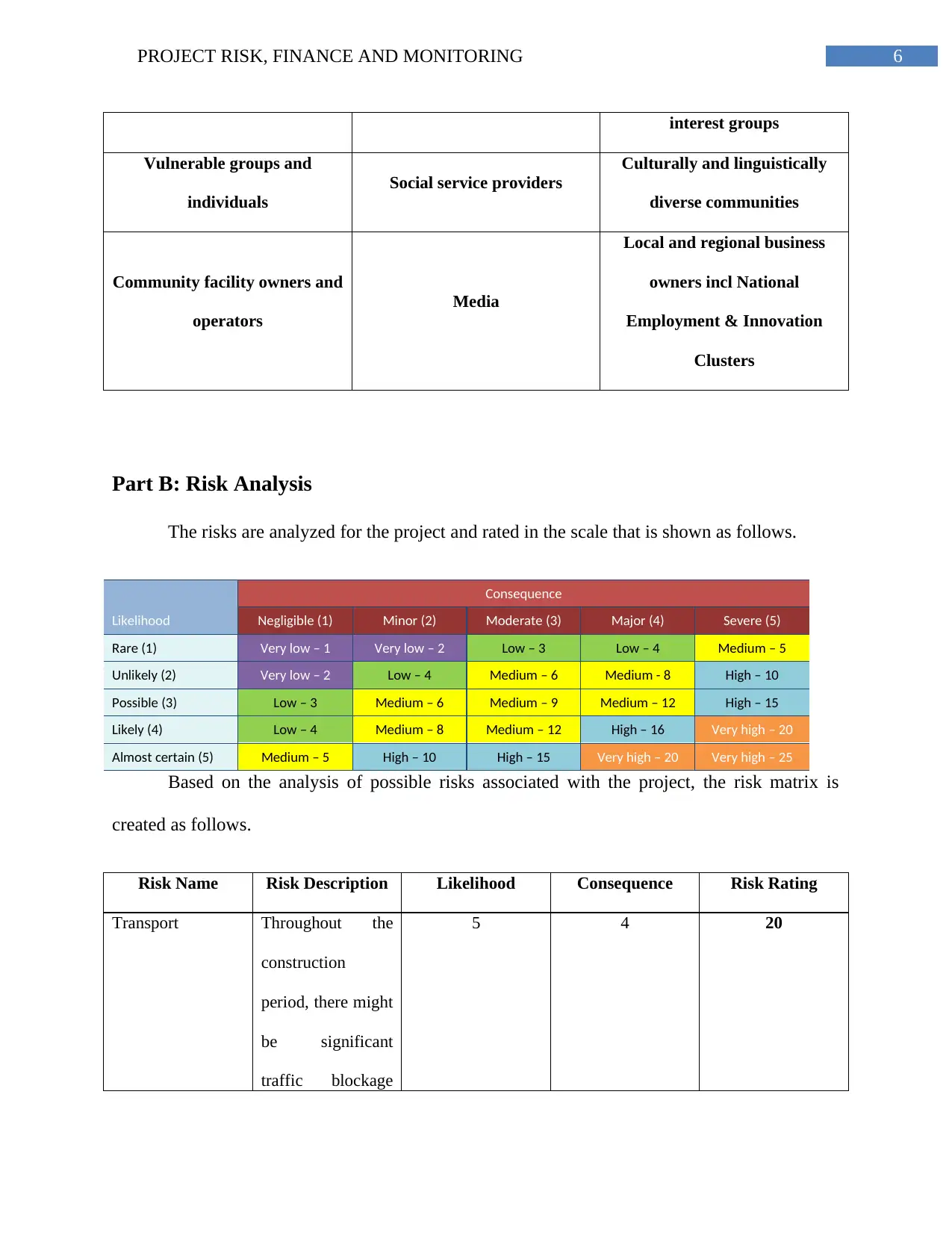
6PROJECT RISK, FINANCE AND MONITORING
interest groups
Vulnerable groups and
individuals
Social service providers
Culturally and linguistically
diverse communities
Community facility owners and
operators
Media
Local and regional business
owners incl National
Employment & Innovation
Clusters
Part B: Risk Analysis
The risks are analyzed for the project and rated in the scale that is shown as follows.
Likelihood
Consequence
Negligible (1) Minor (2) Moderate (3) Major (4) Severe (5)
Rare (1) Very low – 1 Very low – 2 Low – 3 Low – 4 Medium – 5
Unlikely (2) Very low – 2 Low – 4 Medium – 6 Medium - 8 High – 10
Possible (3) Low – 3 Medium – 6 Medium – 9 Medium – 12 High – 15
Likely (4) Low – 4 Medium – 8 Medium – 12 High – 16 Very high – 20
Almost certain (5) Medium – 5 High – 10 High – 15 Very high – 20 Very high – 25
Based on the analysis of possible risks associated with the project, the risk matrix is
created as follows.
Risk Name Risk Description Likelihood Consequence Risk Rating
Transport Throughout the
construction
period, there might
be significant
traffic blockage
5 4 20
interest groups
Vulnerable groups and
individuals
Social service providers
Culturally and linguistically
diverse communities
Community facility owners and
operators
Media
Local and regional business
owners incl National
Employment & Innovation
Clusters
Part B: Risk Analysis
The risks are analyzed for the project and rated in the scale that is shown as follows.
Likelihood
Consequence
Negligible (1) Minor (2) Moderate (3) Major (4) Severe (5)
Rare (1) Very low – 1 Very low – 2 Low – 3 Low – 4 Medium – 5
Unlikely (2) Very low – 2 Low – 4 Medium – 6 Medium - 8 High – 10
Possible (3) Low – 3 Medium – 6 Medium – 9 Medium – 12 High – 15
Likely (4) Low – 4 Medium – 8 Medium – 12 High – 16 Very high – 20
Almost certain (5) Medium – 5 High – 10 High – 15 Very high – 20 Very high – 25
Based on the analysis of possible risks associated with the project, the risk matrix is
created as follows.
Risk Name Risk Description Likelihood Consequence Risk Rating
Transport Throughout the
construction
period, there might
be significant
traffic blockage
5 4 20
Paraphrase This Document
Need a fresh take? Get an instant paraphrase of this document with our AI Paraphraser
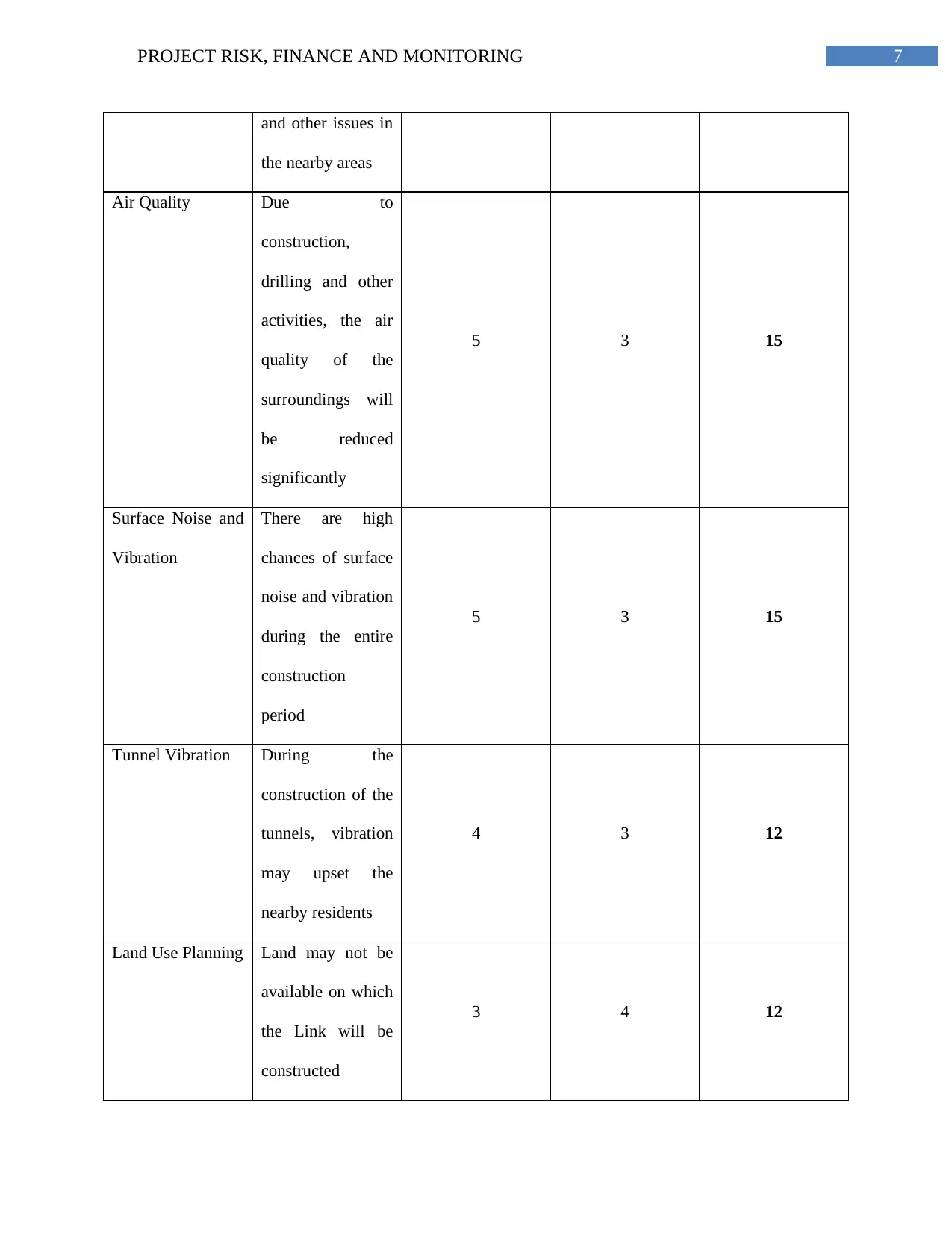
7PROJECT RISK, FINANCE AND MONITORING
and other issues in
the nearby areas
Air Quality Due to
construction,
drilling and other
activities, the air
quality of the
surroundings will
be reduced
significantly
5 3 15
Surface Noise and
Vibration
There are high
chances of surface
noise and vibration
during the entire
construction
period
5 3 15
Tunnel Vibration During the
construction of the
tunnels, vibration
may upset the
nearby residents
4 3 12
Land Use Planning Land may not be
available on which
the Link will be
constructed
3 4 12
and other issues in
the nearby areas
Air Quality Due to
construction,
drilling and other
activities, the air
quality of the
surroundings will
be reduced
significantly
5 3 15
Surface Noise and
Vibration
There are high
chances of surface
noise and vibration
during the entire
construction
period
5 3 15
Tunnel Vibration During the
construction of the
tunnels, vibration
may upset the
nearby residents
4 3 12
Land Use Planning Land may not be
available on which
the Link will be
constructed
3 4 12
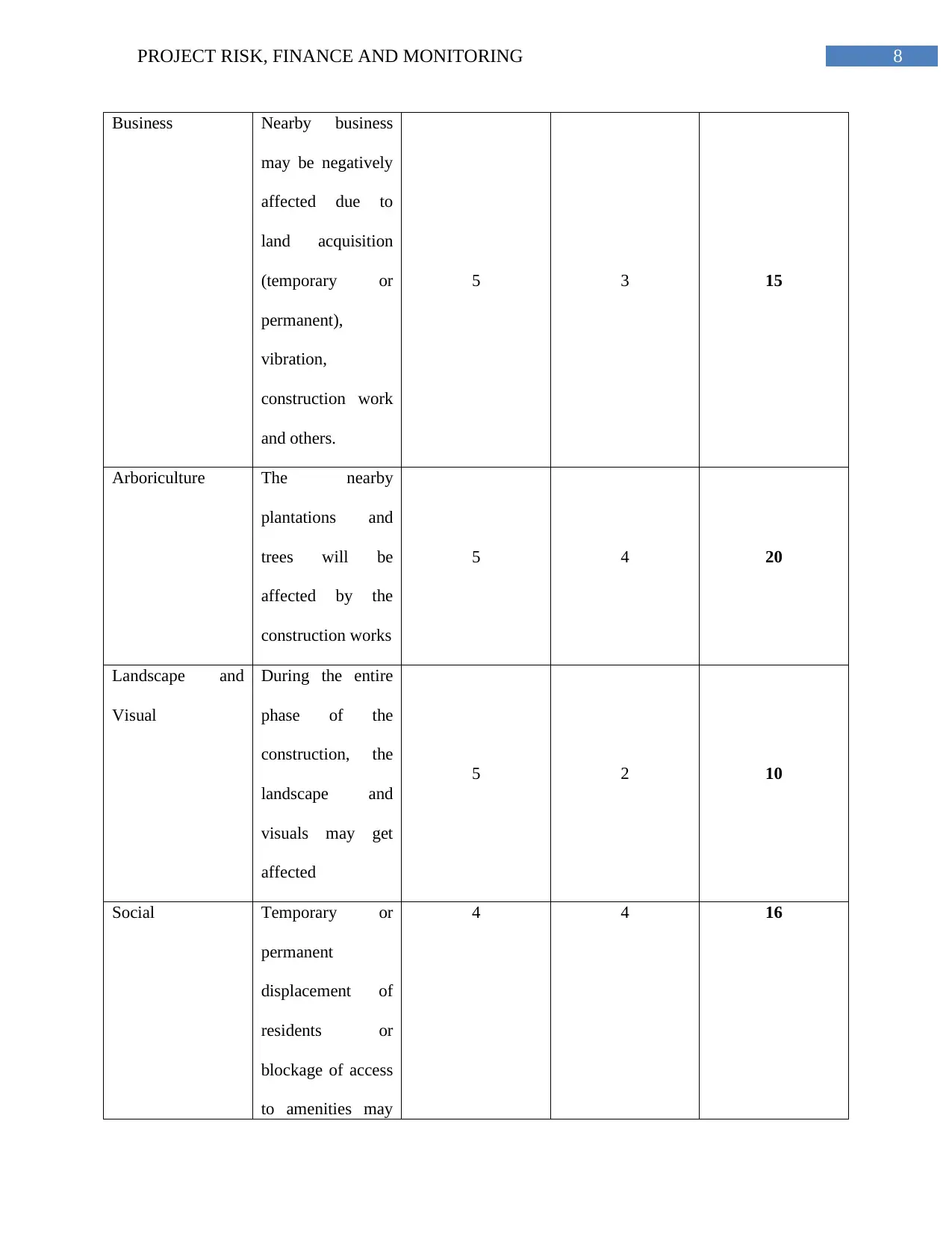
8PROJECT RISK, FINANCE AND MONITORING
Business Nearby business
may be negatively
affected due to
land acquisition
(temporary or
permanent),
vibration,
construction work
and others.
5 3 15
Arboriculture The nearby
plantations and
trees will be
affected by the
construction works
5 4 20
Landscape and
Visual
During the entire
phase of the
construction, the
landscape and
visuals may get
affected
5 2 10
Social Temporary or
permanent
displacement of
residents or
blockage of access
to amenities may
4 4 16
Business Nearby business
may be negatively
affected due to
land acquisition
(temporary or
permanent),
vibration,
construction work
and others.
5 3 15
Arboriculture The nearby
plantations and
trees will be
affected by the
construction works
5 4 20
Landscape and
Visual
During the entire
phase of the
construction, the
landscape and
visuals may get
affected
5 2 10
Social Temporary or
permanent
displacement of
residents or
blockage of access
to amenities may
4 4 16
⊘ This is a preview!⊘
Do you want full access?
Subscribe today to unlock all pages.

Trusted by 1+ million students worldwide

9PROJECT RISK, FINANCE AND MONITORING
occur during the
construction phase
Human Health The pollution
generated during
the construction
process may affect
human health in
the nearby area
5 4 20
Historical Heritage Due to
construction,
nearby historical
heritage buildings
may get affected
4 2 8
Aboriginal
Cultural Heritage
Due to
construction,
nearby aboriginal
cultural heritage
buildings may get
affected
4 2 8
Ground Movement Ground movement
may occur due to
construction of
tunnels, passages,
interchanges and
others.
4 3 12
occur during the
construction phase
Human Health The pollution
generated during
the construction
process may affect
human health in
the nearby area
5 4 20
Historical Heritage Due to
construction,
nearby historical
heritage buildings
may get affected
4 2 8
Aboriginal
Cultural Heritage
Due to
construction,
nearby aboriginal
cultural heritage
buildings may get
affected
4 2 8
Ground Movement Ground movement
may occur due to
construction of
tunnels, passages,
interchanges and
others.
4 3 12
Paraphrase This Document
Need a fresh take? Get an instant paraphrase of this document with our AI Paraphraser
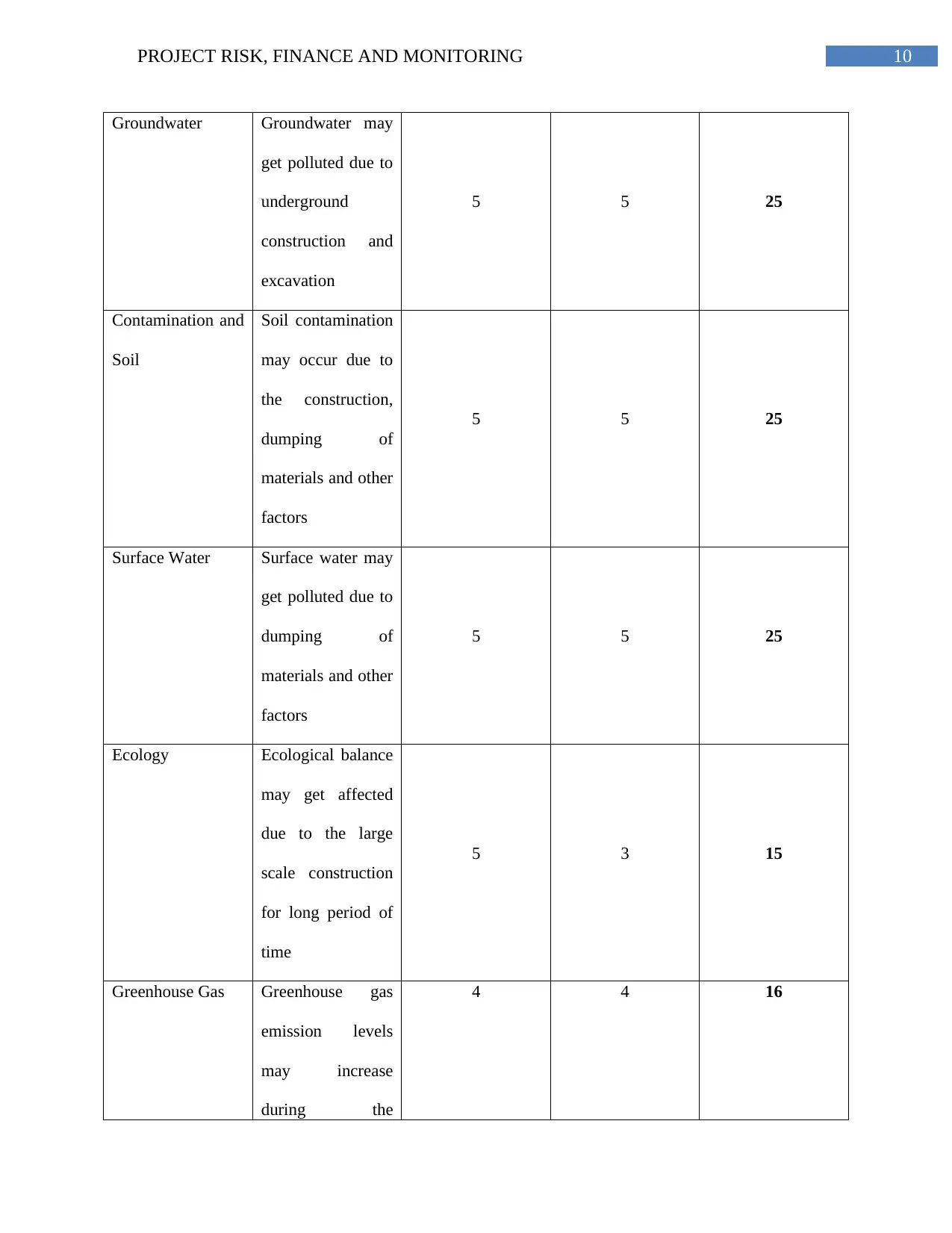
10PROJECT RISK, FINANCE AND MONITORING
Groundwater Groundwater may
get polluted due to
underground
construction and
excavation
5 5 25
Contamination and
Soil
Soil contamination
may occur due to
the construction,
dumping of
materials and other
factors
5 5 25
Surface Water Surface water may
get polluted due to
dumping of
materials and other
factors
5 5 25
Ecology Ecological balance
may get affected
due to the large
scale construction
for long period of
time
5 3 15
Greenhouse Gas Greenhouse gas
emission levels
may increase
during the
4 4 16
Groundwater Groundwater may
get polluted due to
underground
construction and
excavation
5 5 25
Contamination and
Soil
Soil contamination
may occur due to
the construction,
dumping of
materials and other
factors
5 5 25
Surface Water Surface water may
get polluted due to
dumping of
materials and other
factors
5 5 25
Ecology Ecological balance
may get affected
due to the large
scale construction
for long period of
time
5 3 15
Greenhouse Gas Greenhouse gas
emission levels
may increase
during the
4 4 16
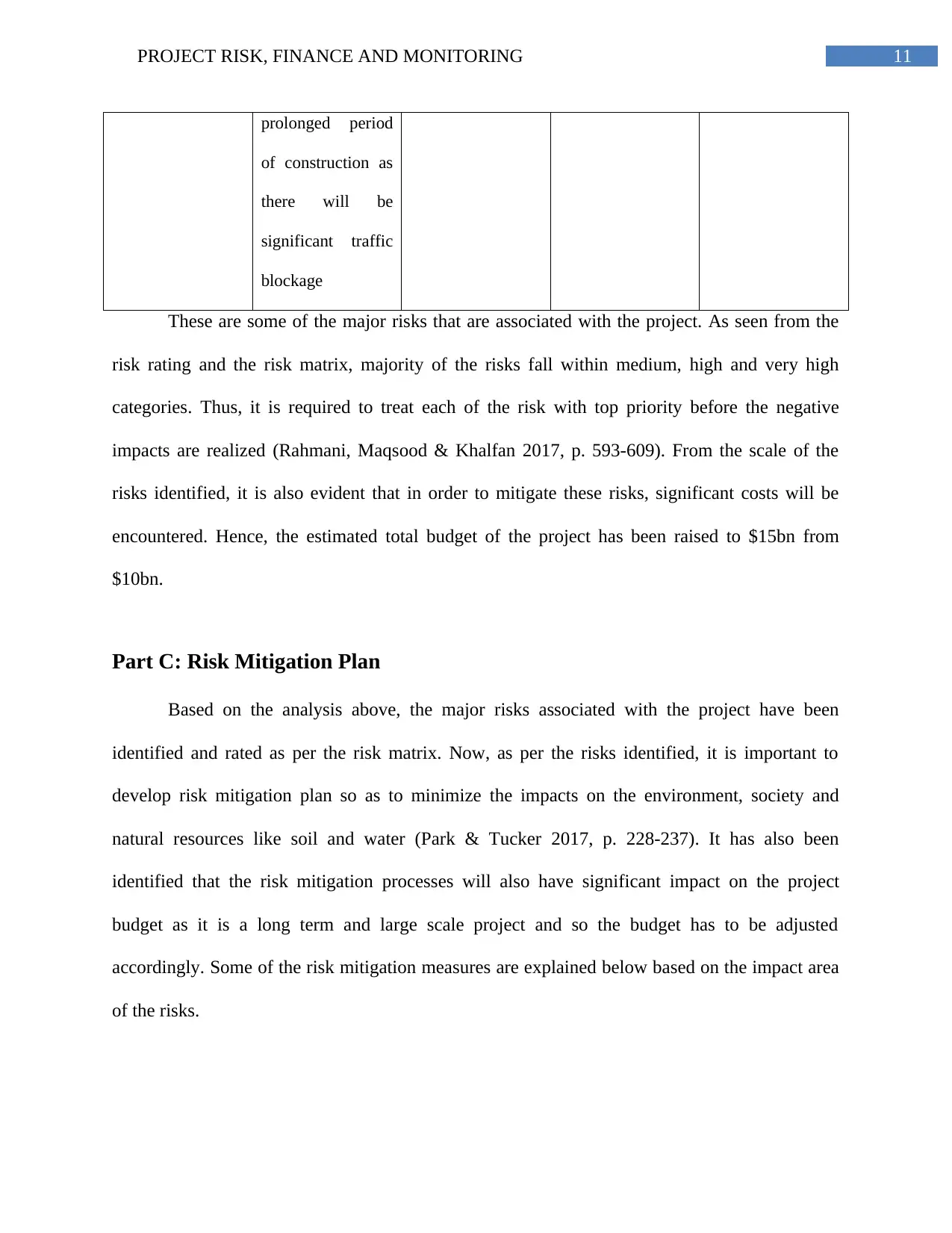
11PROJECT RISK, FINANCE AND MONITORING
prolonged period
of construction as
there will be
significant traffic
blockage
These are some of the major risks that are associated with the project. As seen from the
risk rating and the risk matrix, majority of the risks fall within medium, high and very high
categories. Thus, it is required to treat each of the risk with top priority before the negative
impacts are realized (Rahmani, Maqsood & Khalfan 2017, p. 593-609). From the scale of the
risks identified, it is also evident that in order to mitigate these risks, significant costs will be
encountered. Hence, the estimated total budget of the project has been raised to $15bn from
$10bn.
Part C: Risk Mitigation Plan
Based on the analysis above, the major risks associated with the project have been
identified and rated as per the risk matrix. Now, as per the risks identified, it is important to
develop risk mitigation plan so as to minimize the impacts on the environment, society and
natural resources like soil and water (Park & Tucker 2017, p. 228-237). It has also been
identified that the risk mitigation processes will also have significant impact on the project
budget as it is a long term and large scale project and so the budget has to be adjusted
accordingly. Some of the risk mitigation measures are explained below based on the impact area
of the risks.
prolonged period
of construction as
there will be
significant traffic
blockage
These are some of the major risks that are associated with the project. As seen from the
risk rating and the risk matrix, majority of the risks fall within medium, high and very high
categories. Thus, it is required to treat each of the risk with top priority before the negative
impacts are realized (Rahmani, Maqsood & Khalfan 2017, p. 593-609). From the scale of the
risks identified, it is also evident that in order to mitigate these risks, significant costs will be
encountered. Hence, the estimated total budget of the project has been raised to $15bn from
$10bn.
Part C: Risk Mitigation Plan
Based on the analysis above, the major risks associated with the project have been
identified and rated as per the risk matrix. Now, as per the risks identified, it is important to
develop risk mitigation plan so as to minimize the impacts on the environment, society and
natural resources like soil and water (Park & Tucker 2017, p. 228-237). It has also been
identified that the risk mitigation processes will also have significant impact on the project
budget as it is a long term and large scale project and so the budget has to be adjusted
accordingly. Some of the risk mitigation measures are explained below based on the impact area
of the risks.
⊘ This is a preview!⊘
Do you want full access?
Subscribe today to unlock all pages.

Trusted by 1+ million students worldwide
1 out of 17
Related Documents
Your All-in-One AI-Powered Toolkit for Academic Success.
+13062052269
info@desklib.com
Available 24*7 on WhatsApp / Email
![[object Object]](/_next/static/media/star-bottom.7253800d.svg)
Unlock your academic potential
Copyright © 2020–2025 A2Z Services. All Rights Reserved. Developed and managed by ZUCOL.





